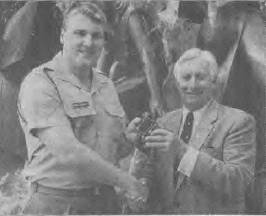- Author
- Cranston, Frank
- Subjects
- History - WW2
- Tags
-
- RAN Ships
- HMAS Australia II
- Publication
- December 1996 edition of the Naval Historical Review (all rights reserved)
One of Australia’s major naval tragedies of World War II has had its echo in Canberra more than 50 years later. Commodore (retired) M. Rayment of the Royal Australian Navy, of Red Hill, has taken possession of a pair of binoculars used by his father, Commander J.F. Rayment, RAN up to the time of his death aboard the heavy cruiser HMAS Australia on October 21, 1944. Thanks to the astuteness of Army Sergeant Mark Holloway, Commodore Mike Rayment learned only recently that the binoculars existed.
Sergeant Holloway’s grandfather, Petty Officer Coxswain Eric Hubber, was also aboard the Australia when the first kamikaze attack of the war was launched against her in Philippine waters, but he was lucky enough not to be among the 30 killed nor 63 injured. He died about eleven years ago.
It was while researching his grandfather’s life that Sergeant Holloway made the connection between accounts of the Battle of Leyte Gulf and the old pair of binoculars which had been among his grandfather’s possessions when he died. Suddenly as he read official accounts of the battle, Sergeant Holloway came to realise that the “J.F. Rayment” etched into a pair of field glasses indicated that they had been owned by Commander Rayment who was killed in the kamikaze attack which, incidentally, had opened up a new strategy in naval warfare.

Inquiries forwarded to the navy revealed that a Commodore Mike Rayment (retired) was living in Canberra. Commodore Rayment said he had been delighted to receive his late father’s field glasses which were different from the standard naval issue of the times. “I was only 11 when my dad was killed,” Commodore Rayment said.
“I didn’t really know what he might have left behind though my mother said often she was disappointed there had not been more personal effects though I gather that might have been because of the very serious nature of his injuries. I joined the navy myself in 1947 and served until 1987”.
“It’s great that the glasses have been so well preserved and I have thanked Sergeant Holloway for a first class piece of historical research as well as a good bit of detective work. The glasses are in excellent condition though they might need a bit of adjustment.”
Canberra Times 30.9.96




